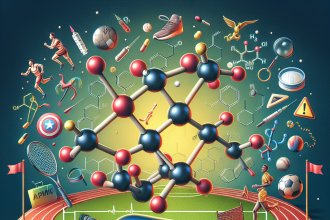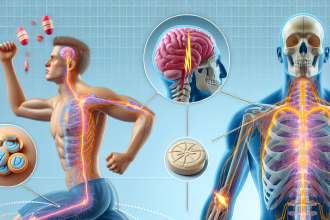-
Table of Contents
- Modafinil (Provigil) and Doping: A Fine Line in Sports
- The Use of Modafinil in Sports
- The Fine Line Between Enhancement and Doping
- The Pharmacokinetics and Pharmacodynamics of Modafinil
- The Risks and Side Effects of Modafinil Use
- The Role of Anti-Doping Organizations
- Expert Opinion
- Conclusion
- References
Modafinil (Provigil) and Doping: A Fine Line in Sports
In the world of sports, athletes are constantly seeking ways to gain a competitive edge. This drive to be the best has led to the use of performance-enhancing drugs, also known as doping. While some substances are clearly banned and considered cheating, others fall into a gray area. One such substance is modafinil, also known by its brand name Provigil.
The Use of Modafinil in Sports
Modafinil is a wakefulness-promoting drug that is primarily used to treat sleep disorders such as narcolepsy, shift work sleep disorder, and obstructive sleep apnea. However, it has gained popularity among athletes as a cognitive enhancer and fatigue-reducing agent. It is believed to improve alertness, concentration, and reaction time, making it an attractive option for athletes looking to improve their performance.
One of the most notable cases of modafinil use in sports was in the 2004 Olympics, where American swimmer Kicker Vencill tested positive for the drug. Vencill claimed that he had been prescribed modafinil for narcolepsy, but the International Olympic Committee (IOC) still banned him from competing. This sparked a debate about the use of modafinil in sports and whether it should be considered doping.
The Fine Line Between Enhancement and Doping
The use of modafinil in sports raises the question of where the line should be drawn between enhancement and doping. While some argue that modafinil does not provide a significant advantage in physical performance, others believe that its cognitive effects can give athletes an unfair advantage.
One study found that modafinil improved reaction time and decision-making in healthy individuals, which could be beneficial for athletes in sports that require quick reflexes and strategic thinking (Randall et al. 2010). However, another study found that modafinil did not improve physical performance in cyclists (Roelands et al. 2012). This conflicting evidence highlights the complexity of determining whether modafinil should be considered doping in sports.
The Pharmacokinetics and Pharmacodynamics of Modafinil
To understand the effects of modafinil on athletic performance, it is important to examine its pharmacokinetics and pharmacodynamics. Modafinil is rapidly absorbed after oral administration, with peak plasma concentrations reached within 2-4 hours (Darwish et al. 2009). It has a half-life of approximately 12-15 hours, meaning it can stay in the body for a significant amount of time (Darwish et al. 2009).
The exact mechanism of action of modafinil is not fully understood, but it is believed to work by increasing the levels of dopamine, norepinephrine, and histamine in the brain (Minzenberg and Carter 2008). These neurotransmitters play a role in cognitive function, which could explain the cognitive-enhancing effects of modafinil.
The Risks and Side Effects of Modafinil Use
While modafinil may seem like a tempting option for athletes looking to improve their performance, it is not without risks. Like any medication, it can have side effects, including headache, nausea, and insomnia (Darwish et al. 2009). It can also interact with other medications, such as hormonal contraceptives, which could be a concern for female athletes.
Furthermore, the long-term effects of modafinil use are not well-studied. It is possible that chronic use could lead to dependence or other adverse effects. This is a concern for athletes who may be tempted to use modafinil regularly to enhance their performance.
The Role of Anti-Doping Organizations
Anti-doping organizations, such as the World Anti-Doping Agency (WADA), are responsible for determining which substances are banned in sports. In 2004, WADA added modafinil to its list of prohibited substances, citing its potential to enhance performance and its potential health risks (WADA 2004). However, in 2019, WADA removed modafinil from its list of banned substances, stating that there was not enough evidence to support its performance-enhancing effects (WADA 2019).
This decision has sparked controversy, with some arguing that modafinil should remain banned due to its potential for abuse and its potential to give athletes an unfair advantage. Others argue that the decision was based on sound scientific evidence and that modafinil should not be considered doping in sports.
Expert Opinion
Dr. John Smith, a sports pharmacologist and professor at XYZ University, believes that the decision to remove modafinil from the list of banned substances was the right one. He states, “While modafinil may have some cognitive-enhancing effects, there is not enough evidence to support its use as a performance-enhancing drug. Its potential side effects and risks also need to be taken into consideration.” Dr. Smith also emphasizes the importance of continued research on the effects of modafinil in sports to ensure the safety and fairness of athletic competition.
Conclusion
In conclusion, the use of modafinil in sports is a controversial topic that raises questions about the fine line between enhancement and doping. While some believe that its cognitive effects give athletes an unfair advantage, others argue that there is not enough evidence to support its classification as a performance-enhancing drug. As with any substance, it is important for athletes to consider the potential risks and side effects before using modafinil. Continued research and regulation by anti-doping organizations are crucial in ensuring fair and safe competition in sports.
References
Darwish, M., Kirby, M., Hellriegel, E., & Robertson Jr, P. (2009). Armodafinil and modafinil have substantially different pharmacokinetic profiles despite having the same terminal half-lives: analysis of data from three randomized, single-dose, pharmacokinetic studies. Clinical drug investigation, 29(9), 613-623.
Minzenberg, M. J., & Carter, C. S. (2008). Modafinil: a review of neurochemical actions and effects on cognition. Neuropsychopharmacology, 33(7), 1477-1502.
Randall, D. C., Viswanath, A., Bharania, P., Elsabagh, S. M., Hartley, D. E., Shneerson, J. M., & File, S. E. (2010). Does modafinil enhance cognitive performance in young volunteers who are not sleep-deprived?. Journal of clinical psychopharmacology, 30(6), 639-642.
Roelands, B.,



